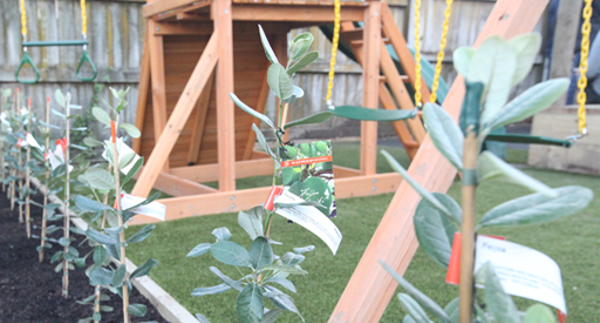
Hedges are a great option to create structure, provide privacy and give character to your garden. Make a statement using evergreen fruit plants like feijoas and create a hedge that is not only beautiful, but also delicious as it becomes laden with tasty fruit!
Shopping List:
- Tui Citrus & Fruit Mix
- Tui NovaTec Premium fertiliser
- Tui Organic Seaweed Plant Tonic
- Fruit trees - feijoas, NZ cranberries or blueberries.
PREPARE
Choosing plants for your edible hedge:
Consider the following: the look you want to create – neatly trimmed and uniform or mixed plant types, tasty fruit you like to eat, and growing conditions i.e. sun, soil, wind, irrigation, climate, and space.
Below are evergreen options for greenery year round and fresh fruit over the summer and autumn months.
Feijoa
- Tolerate wind and coastal conditions.
- Plant a mix of varieties 1m apart to provide cross pollination and to spread the harvest season with early, mid and late ripening varieties.
- Top hedging varieties: Anatoki, Apollo, Kaiteri, Kakariki, Mammoth, Triumph, Unique.
NZ Cranberry (Chilean Guava)
- A bushy plant with delicate pink flowers that produce tasty red berries which can be eaten from the tree or made into jelly and juice.
- Plant half a metre apart to form a hedge.
Blueberry
- Blueberry plants grow naturally as a bushy shrub, up to 1.5m tall or can be pruned to keep at 1m tall.
- Plant around 1m apart to form a delicious and attractive edible hedge.
- A mix of a few varieties is recommended to provide cross pollination and to spread the harvest season. Different varieties also have different foliage colours in summer and autumn, which look really stunning.
- Varieties which go well together to create a hedge include: Misty and Marimba; Climax and Tifblue; Bluecrop and Dixi.
Once you have selected your plants, it is time to get the soil prepared – the better the soil, the better your fruit plants will grow. Dig in organic matter like Tui Sheep Pellets and compost to the area before planting.
When planting several fruit plants at once, it is just as easy to add a layer of Tui Citrus & Fruit Mix before planting.
Follow the below instructions for each plant.
PLANT
The best times to plant are early in the morning or late in the day, so the plants aren’t exposed to the hot sun straight away. Space trees/bushes approximately 1–1.5m apart depending on the variety.
- Soak trees/bushes in a bucket of Tui Organic Seaweed Plant Tonic before planting to help prevent transplant shock and encourage healthy growth.
- Dig a hole approximately twice the depth and width of the root ball of your plant and partly fill with Tui Citrus & Fruit Mix. This has all of the essential nutrients your fruit plants need to get off to the best start.
- Place the plant in the hole, and fill in with Tui Citrus & Fruit Mix, ensuring the plant is no deeper than it was in the container or bag.
- Stake trees when planting.
- Water after planting.
NOURISH
Feed your plants and they will reward you. Plants use nutrients from the soil as they grow, so replenishing the nutrients ensures your fruit plants will grow to their full potential. Feed your edible hedge with Tui NovaTec Premium fertiliser for lush green growth and optimum fruiting. Don’t forget to water your hedge too – especially over the warm summer months as fruit forms. Well watered, well nourished fruit will have a better chance of keeping insect pests and diseases at bay.
Find out more about growing feijoas here
Post a comment
Edible Hedging Guide Comments
Will bluberries grow in the Wairarapa? And can I plant them between feijoa plants, which I have already planted. Will they work/live together?
Ross
Hi Ross, blueberries and feijoas will be fine planted together. Check out our Blueberry Growing Guide which includes some information on which varieties are best suited to certain regions and temperatures
Tui Team